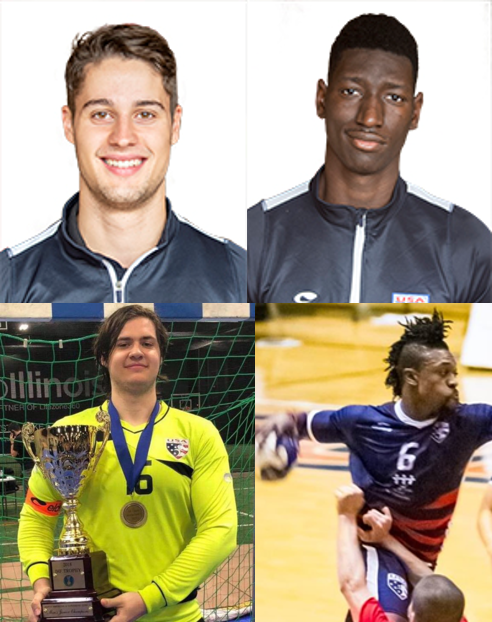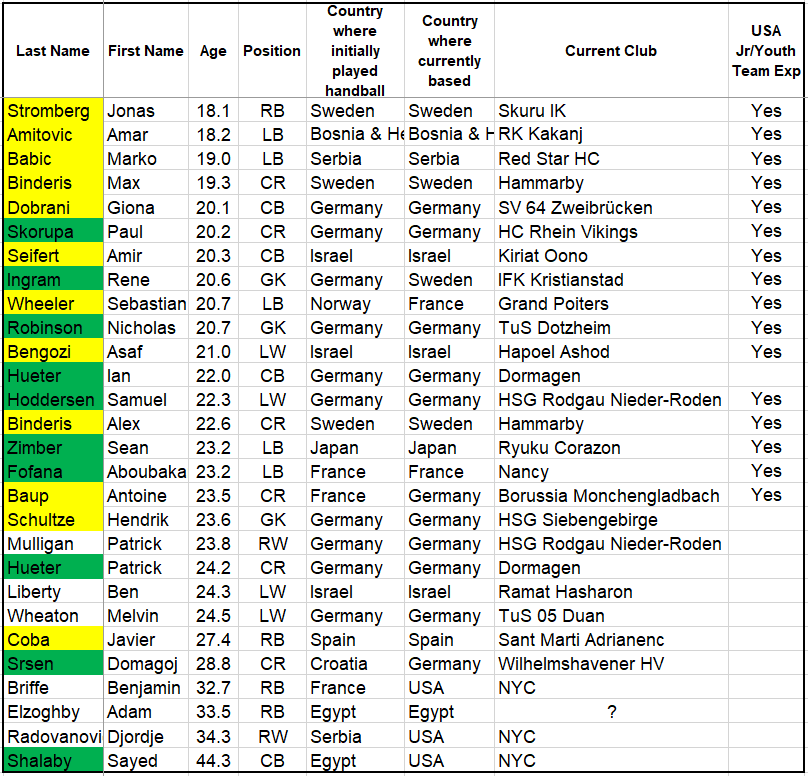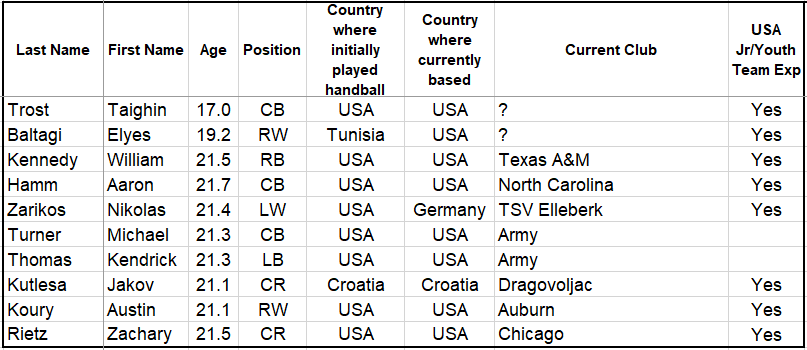
This is part of an ongoing series: Charting a Way Forward for USA Team Handball (2019 Reboot) In the last installment on the U.S. Men, I gave a top level overview of every American male handball player in the world (around 650 athletes). This part reviews assesses the current men’s national team player pool, where they developed their handball skills and projects which athletes will still be contributors in 2024.
The US. Men’s Sr National Team Player Pool
USA Team Handball lists 47 athletes as officially being part of its male Sr Team Player Pool (The website indicates that it was last updated on January 8th, 2019). In addition to that 47, I’ve added 7 athletes that in the past year have either played for the U.S. or have been listed on provisional rosters. (i.e., they probably should be on the list) This brings the overall total to 54 athletes.
There’s a lot of ways to group these athletes for analysis, but I’ve chosen to highlight a few key data points.
- Athletes are split in to two key cohorts (Americans that first played handball in another country/Americans that first played handball in the U.S.): I’d like to again emphasize that splitting these two groups is not meant to be divisive. Every one of these athletes is an American. That being said, any meaningful discussion of the U.S. talent pool has to recognize that the development of these two cohorts is significantly different. (For more insight into expat Americans read this series (Part 1, Part 2, Part 3)
- Athletes are then listed by age
- Athletes selected for the 2019 PANAM Games are highlighted in green
- Athletes that I have assessed as potential candidates for Sr National Team selection in 2024 are highlighted in yellow: It goes without saying that my assessment (or anyone’s assessment for that matter) is going to have some errors. That being said, some of these assessments were not tough calls, but simply a logical projection based on current playing ability, years the athlete has been playing and their age.
U.S. Player Pool (Americans that First Played Handball in Another Country)

A few observations
- This is a solid core group of athletes and more importantly they are also mostly on the younger side.
- Most of the younger athletes have participated in Youth and/or Jr national team competitions.
U.S. Player Pool (Americans that First Played Handball in the U.S)

(Note: The ages in the “age started playing handball” are estimates based on when and where athletes started playing.)
A few observations:
- A few “diamonds in the rough” have been discovered state side, but the overall numbers are disappointing.
- Only a handful of these athletes have been on Youth and/or Jr teams. This is primarily due to to the athletes not starting to play handball until they were older.
- The 5 year Auburn Residency Program (2013-2018) accounts for 17 of the 54 athletes in the U.S. player pool. (16 stateside, plus Sean Zimber who first played handball in Japan). Of that 17, I’ve assessed that only 4 athletes (Zimber, Lee, Reed and Inahara) have solid potential for making future rosters. Some of the Auburn athletes listed aren’t even actively playing handball anymore, so they will surely disappear when the pool list is updated. And, it should also be noted that both Reed (27) and Inahara (29) are also older (for their current level of handball skills development) than desired.
- Only 8 athletes have come from the college ranks and 5 of those athletes were co-located with the Auburn Residency Program. The only college developed product with 2024 potential is circle runner, Drew Donlin, who first played handball at Air Force. And, Donlin (27) is also older (for his current level of handball skills development) than desired.
- The outlier or the model to copy?: Gary Hines, at age 35 is still contributing and someone that I think has more years left in the tank. He is also arguably the very best stateside athlete to never have participated in a residency program. Is he a strange outlier or a model for development that should be studied and copied?
Talent Beyond the Current Pool
There are also several athletes that currently aren’t in the U.S. Sr Team Pool. This would include all of our college athletes as well as any athletes that have participated on U.S. National Youth and Jr teams the past few years. For this list I’ve included all the athletes on our recent U21 World Championship team that aren’t already in the player pool as well as a few prospects from our college and youth programs.

Observations
- The very best Jr players have already been identified and placed in the Sr Team talent pools
- The players identified here are a few years away yet from Sr Team consideration
- Nikolas Zarikos, is an interesting test case. To the best of my knowledge he is by far the youngest stateside American to move to Europe to play handball.
Putting it All Together
Overall, it’s pretty clear that based on “what we have” that the U.S. Men’s Sr National Team will be relying heavily on Expat Americans for the foreseeable future. Over the past several years we have developed only a handful of stateside prospects and in most cases these athletes have either been older and/or less athletically gifted than desired. Bottom line: Our stateside development strategies have not worked as well as we would like them too.
On the positive side of things we have a solid core of Expat Americans. With those athletes and a few supplemental stateside prospects we can put together a respectable side. A team that can battle Cuba and Greenland for a North American & Caribbean championship and qualify for a World Championship. But, can such a team beat Argentina, Brazil and even Chile for a PANAM Games title in 2023 and Olympic qualification? A much tougher ask and it’s doubtful that we can get there with “what we have.”
I know some folks might want to immediately jump to solutions. To start implementing plans that will change “what we have” to “what we want”. However, there’s still a lot more homework that needs to be done. Future installments will take an even closer at our Sr National Team talent by position and at our opposition.